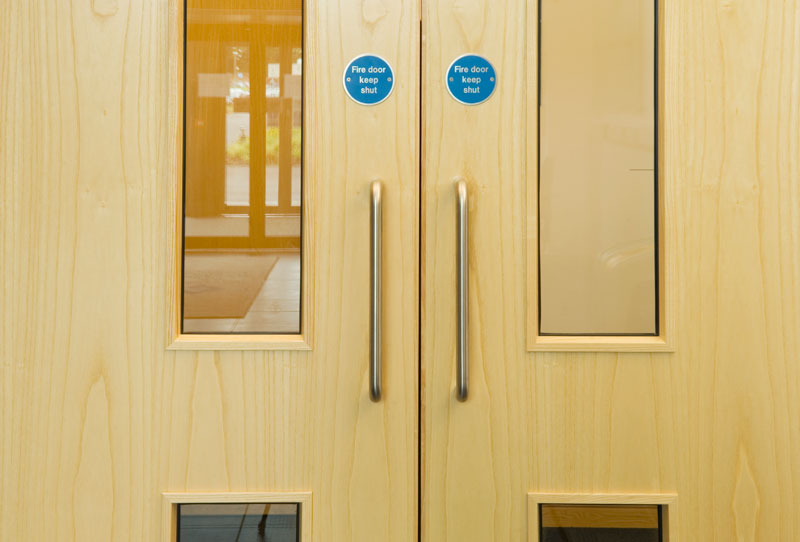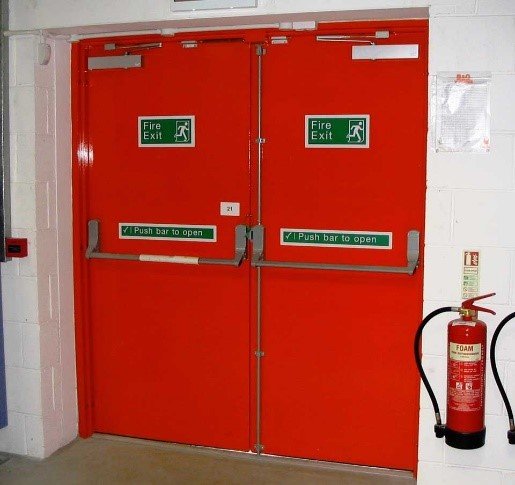Fire Doors: Understanding Their Role in Fire Defense and Safety And Security Codes
Fire Doors: Understanding Their Role in Fire Defense and Safety And Security Codes
Blog Article
Comprehending the Different Kinds Of Fire Doors for Improved Safety And Security
From basic fire-rated doors that shield against flames to acoustic fire doors that use both fire resistance and audio insulation, each type is made with particular features in mind. The assimilation of glass fire doors and the need of fire departure doors better highlight the diverse nature of fire door applications.
Standard Fire-Rated Doors
Standard fire-rated doors are an important component in ensuring structure safety and security and compliance with fire policies. These doors are specifically made to withstand the spread of fire and smoke, offering vital protection to occupants and home. Created from materials such as steel, plaster, and fireproof wood, they can endure heats and maintain structural integrity for differing durations, typically ranging from 20 mins to three hours.
The efficiency of typical fire-rated doors is quantified by their fire-resistance score, which is determined via extensive testing under controlled conditions. This ranking shows the duration throughout which the door can include flames and heat, therefore allowing added time for discharge and emergency action. Additionally, these doors typically include intumescent seals that broaden when exposed to heat, further stopping the passage of smoke and poisonous gases.
Installation of common fire-rated doors must follow strict building regulations and criteria, such as those set by the National Fire Defense Association (NFPA) and the International Structure Code (IBC) Routine evaluations and upkeep are important to make sure that these doors function appropriately in an emergency. Effectively installed and preserved fire-rated doors are important in boosting overall structure safety and lessening fire-related dangers.
Smoke Doors
Smoke doors play a pivotal role in fire safety and security by particularly dealing with the containment of smoke, which is frequently more hazardous than flames during a fire case. Smoke breathing can bring about severe breathing concerns, disorientation, and even fatalities, making smoke doors a vital part in emergency situation preparation. These doors are created to restrict the movement of smoke between various compartments within a building, thereby giving more secure emptying routes and reducing possible damage to residential or commercial property.

Additionally, smoke doors are typically equipped with automatic closing systems, set off by smoke detectors or fire alarm systems, to ensure they close promptly throughout an emergency. By containing smoke, these doors aid keep lower temperatures and clearer visibility in getaway courses, making them a vital element in detailed fire security techniques. Their proper setup and upkeep are important to ensure ideal performance when most required.
Acoustic Fire Doors
Acoustic fire doors offer a twin feature explanation in both fire security and sound attenuation, making them a valuable enhancement to structures where noise control is essential. These doors are crafted to not only satisfy strenuous fire resistance criteria yet likewise to considerably reduce audio transmission, consequently improving overall structure performance.
The construction of acoustic fire doors commonly involves a combination of dense materials and specialized seals. These components work with each other to develop a reliable obstacle versus both fire and noise. High-density cores, such as mineral boards or composite materials, are frequently made use of in the door fallen leave to make the most of sound insulation. Furthermore, the door frame and seals are developed to keep acoustic integrity while supplying robust fire resistance.
Acoustic fire doors are especially helpful in atmospheres where personal privacy and silent are paramount, such as hospitals, hotels, and universities. They aid to keep a relaxed atmosphere by minimizing the transmission of noise between spaces or hallways while making sure conformity with fire security guidelines. Along with their practical advantages, these doors can be customized to blend effortlessly with the architectural visual appeals of a building, making sure that safety and security does not come at the expense of design.

Glass Fire Doors
Glass fire doors, regularly used in modern-day architectural designs, offer a blend of openness and security that conventional fire doors can not match. These doors incorporate the additional reading visual appeal of glass with important fire-resistant buildings, making them an optimal selection for contemporary structures. Engineered with specialized fire-resistant glazing, glass fire doors can endure high temperature levels and protect against the spread of flames and smoke for a specified duration, usually ranging from 30 to 120 mins.
The building and construction of glass fire doors involves numerous layers of toughened up glass, commonly treated with intumescent materials that increase when revealed to heat, additional boosting their fire-resistant abilities. These doors are not only useful in regards to fire safety and security however likewise enable natural light to permeate through spaces, contributing to energy effectiveness and an extra read this welcoming atmosphere.
Furthermore, glass fire doors can be incorporated with different framework products such as steel or light weight aluminum, which give added structural assistance and resilience. Making use of such doors is specifically helpful in industrial, instructional, and medical care setups where exposure and safety are critical. By meeting strict fire safety laws and preserving an open, modern-day aesthetic, glass fire doors represent an essential advancement in fireproof building.

Fire Departure Doors
Fire escape doors are a crucial part of any type of building's safety and security framework, made to provide a swift and protected means of egress during emergencies. These doors are purposefully located to make certain occupants can rapidly and securely leave the properties in case of a fire or various other unsafe scenarios. Unlike typical doors, fire escape doors have to stick to stringent regulatory criteria, ensuring they can execute reliably under duress.
A crucial feature of fire leave doors is their ability to open quickly from the within, generally furnished with panic bars or push pads. This layout facilitates rapid emptying and stops traffic jams that can take place throughout high-stress situations. Additionally, fire escape doors are often constructed from fire-resistant materials to avoid the spread of flames and smoke, thus providing vital extra time for discharge and firefighting efforts.
An additional important aspect is the clear signs and lighting connected with fire leave doors. Eventually, the performance of fire exit doors is a vital aspect in safeguarding lives and decreasing residential or commercial property damages throughout emergency situations.
Conclusion
In summary, recognizing the different types of fire doors, including conventional fire-rated doors, smoke doors, acoustic fire doors, glass fire doors, and fire exit doors, is vital for improving security in buildings. Each type supplies specific benefits, from fire and smoke containment to appear insulation and aesthetic integration, making certain comprehensive protection. Fire doors. Routine upkeep and compliance with safety and security criteria are necessary to assure their performance in securing occupants and facilitating secure emptying throughout emergencies
Report this page